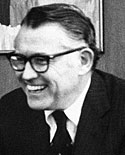Horton Guyford Stever
DOI: 10.1063/1.3563828
Horton Guyford Stever, a legendary figure in the history of science and science policy during and following World War II, died on 9 April 2010 at his home in Gaithersburg, Maryland.
Born on 24 October 1916 in Corning, New York, Guy was a physicist to his core. He received his BS in physics in 1938 from Colgate University and his PhD in physics from Caltech in 1941. He worked on cosmic rays and mechanisms with Geiger counter discharge; one part of his thesis was on the lifetime of the meson. In 1940 his thesis adviser, Victor Neher, went to MIT to work in its new radiation laboratory and assigned a young instructor at Caltech, William Pickering, to act as Guy’s adviser.
After he received his PhD, Guy proceeded to the MIT Radiation Laboratory, where he was involved in the development of radar. He observed that the broad education of physicists allowed them to effectively develop the new technology; such observations were to have a profound effect on how Guy would approach engineering education.
His ability to operate in several arenas at once, a skill he used often during his career, led Guy to accept an assignment during World War II to go to the UK and be a liaison between British and American scientists. As part of a scientific delegation, he accompanied American troops during their push into Germany. His mission was to obtain materials from German scientific sites. One tale is that his group of scientists did an assignment so well that they reached a German radar site ahead of the American ground troops; fortunately, the Germans surrendered to the scientists.
After World War II, Guy went back to MIT, where he served in a number of positions: faculty member in aeronautics, associate dean of engineering, and head of the mechanical engineering department. I first met him in 1958 when I was a junior at MIT; he regaled students with stories of his wartime adventures.
Along with Vannevar Bush and other senior and seasoned scientists, Guy was instrumental in helping to shape the important transition in government funding of research for national needs and in founding NSF in 1950.
With the launch of Sputnik 1 in 1957, Guy was asked to chair a committee to reexamine the nation’s space program. The committee’s work led directly to the formation of NASA out of the earlier National Advisory Committee for Aeronautics. Following the 1986 Challenger accident, Guy also chaired the National Research Council committee that evaluated the redesign of the booster.
In 1965 Guy became president of the Carnegie Institute of Technology. During his tenure, he oversaw the merger of the institute with the Mellon Institute of Industrial Research to form Carnegie Mellon University. He stepped down as president in 1972 to become director of NSF.
In 1973 Nixon abolished the White House Office of Science and Technology, claiming he was unhappy with the advice he received on antiballistic missiles and supersonic planes. As head of NSF, Guy then functioned as a dual-hatted science adviser for three years, but he had little interaction with the president.
In 1976 Congress complied with President Gerald Ford’s request to reestablish the science advisory office and created the Office of Science and Technology Policy. Among Guy’s priorities as director of the OSTP and as Ford’s science adviser were increased exchanges between American and Soviet scientists, basic research funding, and solar heating commercialization. He strengthened the office by establishing an advisory committee that was the forerunner of the President’s Council of Advisors on Science and Technology.
Following his departure from NSF and the OSTP, Guy made his talents available to a wide variety of scientific and technical organizations by taking up a number of board and committee activities. In 1999 he received the Arthur M. Bueche Award from the National Academy of Engineering “for a lifetime of exceptional service to engineering and society as a researcher, university president, and government official, and for the style of leadership that has made him a preeminent U.S. statesman in science and technology.”

Horton Guyford Stever
AIP ESVA, PHYSICS TODAY COLLECTION

More about the Authors
Sheila E. Widnall. Massachusetts Institute of Technology Cambridge.
